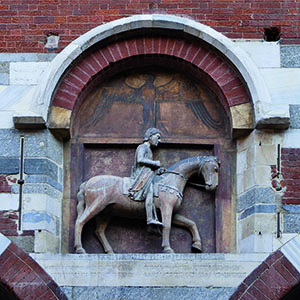IL GRUPPO EQUESTRE DI OLDRADO DA TRESSENO NEL BROLETTO DI MILANO
CON QUALCHE OSSERVAZIONE ALLA LUCE DEI RECENTI RESTAURI
DOI:
https://doi.org/10.4081/lettere.2022.817Abstract
equestrian statue depicting Oldrado da Tresseno (1233), ostentatiously placed in a niche in the centre of the southern façade of the 13th-century Palazzo della Ragione in the Broletto in Milan, represents one of the first large equestrian monuments of the mediaeval age and an early inspiration to those of Antiquity. Described and commented on, as early as the 14th century (Galvano Fiamma), as a self-celebratory portrait by a podestà, the relief, as widely acknowledged by critics, especially in the 20th century, undoubtedly presents stylistic features ascribable to the Antelami workshop and indeed at times attributed directly to Benedetto Antelami. This study proposes, also following other interventions by the author, the attribution to a sculptor who worked with Antelami in Parma, and who executed some works at the Cathedral of Reggio Emilia, the Cathedral of Fidenza and the Church of St. Andrew in Vercelli. Having confirmed the stylistic characteristics of the staute and briefly examined the historical figure of Oldrado, this essay intends to indicate, also in the light of the inscription engraved under the aedicule that hosts it, how the real reasons for the creation of this sculptural monument do not lie in the desire for self-assertion of the person depicted, but in the symbolic representation of the role and functions of the foreign official whose task it is to govern the city annually, and in particular the administration of justice. In this, the monument constitutes the figurative counterpart of the theoretical reflection that constituted the subject matter of a wide range of treatises produced around the first half of the 13th century on the subject of city government. The theory of the transposition of imperial prerogatives into the figure of the podestà, especially in matters of justice, finds its place in this doctrinaire strand. Hence the reference to the monarchical institution that must find expression in the conduct of the actions and lifestyle of the podestà and even in the municipal palace, likened to a palace, in the same terms used in the inscription under the statue of Oldrado to describe the Town Hall. The doctrinal literature, as well as part of the inscription itself, also refer to legal terms derived from Roman sources of law. All this clarifies the significance of the presence in the aedicule of the large painted eagle above the equestrian statue, symbolising superior imperial power. This element too, in addition to those mentioned, thus contributes to the recognition of the references to equestrian statuary of Antiquity (the Marcus Aurelius in Rome and the 'Regisole' in Pavia) from which Oldrado’s monument is partly inspired. Finally, the analysis was extended to the numerous traces of polychromy that have been brought to light by the recent restorations to the entire complex, and which make it possible to reconstruct the probable original layout of the sculpted relief, in which the sumptuous robes of the podestà, not of a military nature, reinforce the reference to royalty. Finally, close examination of the sculpture has allowed us to confirm that the podestà originally held an object in his right hand, probably a sword, as a symbol of Justice.
Downloads


